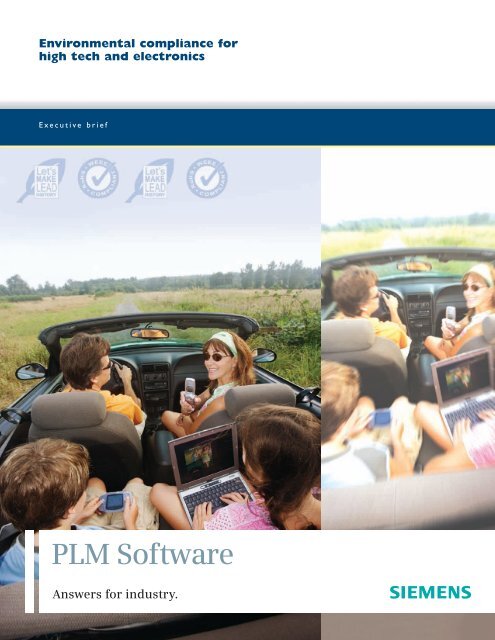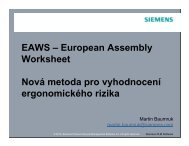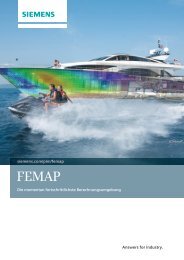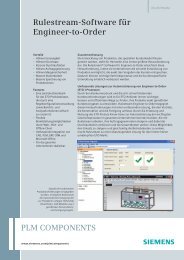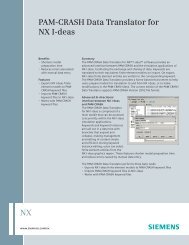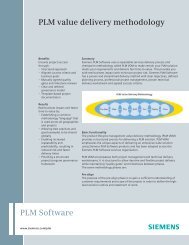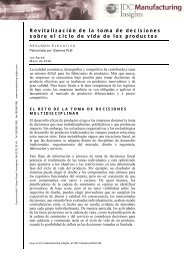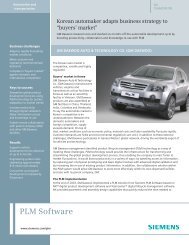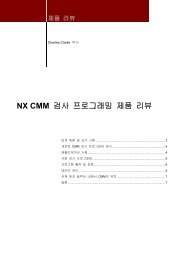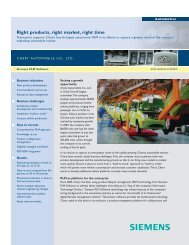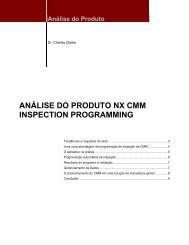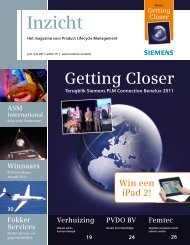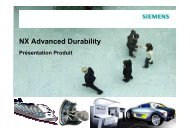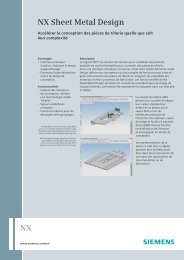Environmental compliance for high tech and electronics
Environmental compliance for high tech and electronics
Environmental compliance for high tech and electronics
Create successful ePaper yourself
Turn your PDF publications into a flip-book with our unique Google optimized e-Paper software.
<strong>Environmental</strong> <strong>compliance</strong> <strong>for</strong><br />
<strong>high</strong> <strong>tech</strong> <strong>and</strong> <strong>electronics</strong><br />
E x e c u t i v e b r i e f<br />
PLM Software<br />
Answers <strong>for</strong> industry.
Ensuring marketplace success in the face of increasing recycling <strong>and</strong> recovery requirements<br />
Executive Summary<br />
A new series of government<br />
m<strong>and</strong>ates requires the re-use,<br />
recycling <strong>and</strong> recovery of electronic<br />
components on an increasingly<br />
more complex <strong>and</strong> pervasive basis.<br />
These requirements challenge the<br />
ability of <strong>high</strong> <strong>tech</strong> <strong>and</strong> <strong>electronics</strong><br />
companies to achieve strategic<br />
profit margins, dem<strong>and</strong>ing time-tomarket<br />
schedules <strong>and</strong> target<br />
market accessibility. Siemens PLM<br />
Software provides solutions that<br />
enable companies to establish a<br />
business strategy that builds<br />
<strong>compliance</strong> into product lifecycle<br />
processes.These solutions enable<br />
product makers to quickly comply<br />
with changing market requirements,<br />
manage part obsolescence,<br />
capture data from their suppliers<br />
more effectively, better manage<br />
their inventory <strong>and</strong> enhance their<br />
manufacturing process controls<br />
<strong>and</strong> <strong>compliance</strong> reporting<br />
capabilities.<br />
Recent environmental, health <strong>and</strong><br />
safety concerns have m<strong>and</strong>ated<br />
the establishment of new<br />
directives governing the usage,<br />
manufacturing <strong>and</strong> disposal of<br />
hazardous substances. These<br />
m<strong>and</strong>ates are particularly<br />
important to the <strong>high</strong> <strong>tech</strong> <strong>and</strong><br />
<strong>electronics</strong> industry – where two<br />
new European Union directives<br />
apply rigorous environmental<br />
regulations to products sold.<br />
<strong>Environmental</strong> m<strong>and</strong>ates<br />
govern global product<br />
development<br />
The Restriction on the use of<br />
Hazardous Substances (RoHS)<br />
directive bans electrical <strong>and</strong><br />
electronic equipment containing<br />
more than set levels of<br />
hazardous substances. The intent<br />
of this legislation is to reduce the<br />
amount of hazardous chemicals<br />
that may leak out of l<strong>and</strong>fill sites<br />
or otherwise contaminate the<br />
environment during end-of-life<br />
recycling/disposition. The<br />
directive also requires that all<br />
products sold be fully RoHScompliant<br />
<strong>and</strong> “lead-free.”<br />
The Waste from Electrical <strong>and</strong><br />
Electronic Equipment (WEEE)<br />
directive deals with the<br />
collection, treatment, recovery<br />
<strong>and</strong> recycling of electrical <strong>and</strong><br />
electronic waste components.<br />
The directive assigns<br />
responsibility <strong>for</strong> the disposal of<br />
associated hazardous waste to<br />
either the producers or users of<br />
these products. As a result,<br />
producers/users are required to<br />
recycle electrical <strong>and</strong> electronic<br />
equipment at the end of its<br />
useful life <strong>and</strong> are prohibited<br />
from disposing of this equipment<br />
in l<strong>and</strong>fills, as well as by other<br />
unauthorized methods. Manufacturers<br />
must be in <strong>compliance</strong><br />
with these new regulations in<br />
order to sell <strong>and</strong> ship their<br />
products.<br />
While these two directives<br />
directly affect the European<br />
Actively developing<br />
RoHS legislation<br />
RoHS <strong>and</strong> WEEE<br />
hazardous substances<br />
banned July 1, 2006
Union, environmental <strong>compliance</strong><br />
is not limited to Europe. Within<br />
the next two years, 15 of the<br />
world’s largest economies –<br />
including China <strong>and</strong> Japan – are<br />
expected to have similar legislation<br />
in place.<br />
Compliance is a<br />
value-chain issue<br />
With <strong>compliance</strong>-related<br />
requirements rapidly gaining ground<br />
<strong>and</strong> deadlines approaching, it is<br />
imperative that <strong>high</strong> <strong>tech</strong> <strong>and</strong><br />
<strong>electronics</strong> companies develop a<br />
strategy to reduce <strong>compliance</strong><br />
risk in order to effectively<br />
compete in today’s global<br />
marketplace. This ef<strong>for</strong>t requires<br />
that all participants in the <strong>high</strong><br />
<strong>tech</strong> <strong>and</strong> <strong>electronics</strong> value chain<br />
involve themselves in these<br />
initiatives. Companies must<br />
visibly raise this issue <strong>and</strong> explain<br />
its importance not only within<br />
their own internal operations but<br />
also with their suppliers <strong>and</strong><br />
customers. This business<br />
“It is interesting what (effect) regulation <strong>and</strong><br />
<strong>compliance</strong> has (had since it became a business<br />
requirement). Now, even our legal staff (<strong>and</strong>) our<br />
lawyers are involved in product development…<br />
because we have put these <strong>compliance</strong>s up front<br />
in our product development.”<br />
Dr. R<strong>and</strong>all Led<strong>for</strong>d<br />
Vice President <strong>and</strong> CTO<br />
Emerson Corp<br />
Voluntarily<br />
participating<br />
in RoHS<br />
imperative requires massive<br />
amounts of collaboration (<strong>for</strong><br />
example, in redesign ef<strong>for</strong>ts that<br />
apply to obsolete components<br />
<strong>and</strong> materials), as well as designin-<strong>compliance</strong><br />
initiatives that<br />
need to be implemented in value<br />
chain processes.<br />
Companies that view<br />
environmental <strong>compliance</strong> as<br />
only a reporting issue face<br />
recurring costs <strong>and</strong> increased<br />
risk that arise from late-term<br />
changes, manufacturing process<br />
delays <strong>and</strong> slow market launches.<br />
Hazardous substances<br />
banned July 1, 2006<br />
Voluntarily<br />
participating<br />
in RoHS
The risks of non<strong>compliance</strong><br />
are costly<br />
Non<strong>compliance</strong> can jeopardize a<br />
company’s profits, market share<br />
<strong>and</strong> competitive position.<br />
Halted shipments can result when<br />
companies are unable to deliver<br />
complete or correct <strong>compliance</strong><br />
documents. Significant shipping<br />
delays can occur if companies fail<br />
to identify <strong>and</strong> document<br />
material attributes.<br />
Delays in the release of critical<br />
design changes can be caused<br />
by part obsolescence, part<br />
specification changes or the<br />
introduction of new suppliers.<br />
Lost competitive position can result<br />
if companies are unable to<br />
competitively bid on environmentally<br />
friendly contracts.<br />
The <strong>compliance</strong> requirements<br />
<strong>for</strong> individual market launches<br />
can be insufficiently validated if<br />
requirements are not fully<br />
captured or if the validation<br />
process can not effectively<br />
re-use existing documents<br />
<strong>and</strong> specifications.<br />
Excessive <strong>and</strong> obsolete inventory<br />
may need to be written off if a<br />
company’s value chain is not able<br />
to share <strong>and</strong> en<strong>for</strong>ce material<br />
consumption rules in a global<br />
manufacturing environment.<br />
Reduce risk with Siemens’<br />
end-to-end environmental<br />
<strong>compliance</strong> solutions<br />
Siemens provides a flexible<br />
framework <strong>for</strong> supporting<br />
internal <strong>and</strong> external environmental<br />
<strong>compliance</strong> initiatives.<br />
Working with Synapsis<br />
Technology, Siemens has created<br />
a comprehensive solution to<br />
help <strong>high</strong> <strong>tech</strong> <strong>and</strong> <strong>electronics</strong><br />
companies meet the <strong>compliance</strong><br />
requirements established by the<br />
RoHS <strong>and</strong> WEEE directives. This<br />
integrated solution enables<br />
organizations to minimize risk<br />
<strong>and</strong> establish/implement a longterm<br />
<strong>compliance</strong> strategy by<br />
leveraging capabilities <strong>for</strong><br />
<strong>compliance</strong> strategy <strong>and</strong> reporting,<br />
design validation <strong>and</strong> manufacturing-<strong>for</strong>-<strong>compliance</strong><br />
initiatives.
Gain key benefits. Siemens<br />
solutions enable <strong>high</strong> <strong>tech</strong> <strong>and</strong><br />
<strong>electronics</strong> companies to:<br />
• Reduce value chain<br />
<strong>compliance</strong> risk<br />
• Ensure product readiness <strong>for</strong><br />
market launch<br />
• Control <strong>compliance</strong> program<br />
implementation costs<br />
• Deliver quick <strong>and</strong> accurate<br />
responses to customer bids<br />
• Save time <strong>and</strong> resources during<br />
the sourcing <strong>and</strong> design cycle<br />
• Avoid costly recalls resulting<br />
from noncompliant products<br />
• Eliminate avoidable <strong>compliance</strong><br />
delays during the manufacturing<br />
process<br />
Set a strategy <strong>and</strong> monitor/<br />
report on <strong>compliance</strong> status.<br />
The Siemens solution<br />
facilitates the collection,<br />
aggregation <strong>and</strong> reporting of<br />
environmental <strong>and</strong> material<br />
content in<strong>for</strong>mation across<br />
the supply chain. The solution<br />
enables <strong>compliance</strong> teams to:<br />
• Establish program milestones<br />
<strong>and</strong> deliverables <strong>for</strong> market<br />
requirements verification.<br />
• Develop material-level<br />
composition lists at the<br />
manufacturer part, company<br />
part, engineered part <strong>and</strong><br />
assembly levels.<br />
• Extend <strong>compliance</strong> analysis into<br />
downstream processes, thereby<br />
ensuring that <strong>compliance</strong><br />
requirements <strong>for</strong> market <strong>and</strong><br />
program milestones are<br />
managed <strong>and</strong> validated against<br />
launch plans.<br />
• Establish data exchange<br />
protocols with suppliers to<br />
facilitate cost effective, rapid<br />
<strong>and</strong> accurate reporting.<br />
• Leverage robust <strong>compliance</strong><br />
reporting capabilities, including<br />
the ability to provide BOM<br />
grading reports <strong>and</strong> support<br />
<strong>compliance</strong> certification.<br />
• Rapidly disseminate a wide<br />
variety of st<strong>and</strong>ard <strong>and</strong><br />
customized reports to<br />
design/quality assurance teams,<br />
external suppliers <strong>and</strong><br />
government regulators by<br />
leveraging today’s most popular<br />
data exchange protocols,<br />
including RosettaNet XML,<br />
IMDS <strong>and</strong> IPC-1752.
Design with <strong>compliance</strong> right from<br />
the start. The Siemens solution<br />
facilitates design-<strong>for</strong>-<strong>compliance</strong><br />
initiatives by enabling design<br />
engineers to validate designs<br />
against environmental <strong>compliance</strong><br />
m<strong>and</strong>ates. This ensures that<br />
product programs treat<br />
<strong>compliance</strong> as a strategic design<br />
concern, thereby reducing the<br />
cost related to engineering change<br />
orders. The Siemens solution<br />
facilitates design validation by<br />
enabling product teams to:<br />
• Store material <strong>and</strong> substance<br />
data as product requirements,<br />
thereby enabling producers to<br />
quickly <strong>and</strong> effectively analyze<br />
components, parts, assemblies<br />
<strong>and</strong> rolled up BOMs.<br />
• Connect end-of-life considerations/requirements<br />
into the<br />
design, thereby ensuring that<br />
each product is designed <strong>for</strong><br />
“disposability” <strong>and</strong> its end-oflife<br />
at the start.<br />
• Provide engineering teams with<br />
visibility to <strong>compliance</strong> status<br />
<strong>and</strong> material composition<br />
during the component<br />
selection process.<br />
• Facilitate automatic sourcing<br />
<strong>and</strong> design <strong>compliance</strong><br />
verification against multiple<br />
industry st<strong>and</strong>ards while<br />
supporting the management of<br />
regulatory exemptions.<br />
Maintain <strong>compliance</strong> throughout<br />
the manufacturing process. By<br />
providing an end-to-end approach<br />
that addresses the entire manufacturing<br />
process, the Siemens<br />
<strong>compliance</strong> solution <strong>for</strong> manufacturing<br />
ensures that a value chain’s<br />
production processes adhere to<br />
all applicable environmental<br />
regulatory m<strong>and</strong>ates. The solution<br />
supports key areas of execution<br />
crucial to manufacturing<br />
<strong>compliance</strong>, including:<br />
• As-built BOM <strong>and</strong> vendor part<br />
in<strong>for</strong>mation management, which<br />
eliminates compliant vs.<br />
noncompliant part number<br />
confusion by implementing a<br />
“component decoder” at the<br />
point of material release to the<br />
shop floor level.<br />
“Managing in<strong>for</strong>mation to support <strong>compliance</strong> is an<br />
enormous challenge <strong>for</strong> business <strong>and</strong> IT professionals.<br />
Organizations of all sizes need an action plan <strong>for</strong><br />
achieving <strong>compliance</strong> <strong>and</strong> mitigating risk in today’s<br />
new world.”<br />
AMR Research: The Product Lifecycle Management Applications<br />
Report, 2003-2008
• Real-time component tracking,<br />
which ensures that only<br />
compliant material is used<br />
during production, including the<br />
change history.<br />
• Change management<br />
capabilities, which document<br />
the entire history of changes<br />
needed to meet traceability<br />
requirements.<br />
• Process verification <strong>and</strong><br />
monitoring of production<br />
operations, which ensures that<br />
compliant processes, trained<br />
operators <strong>and</strong> appropriate<br />
materials are used based on<br />
type of product, period of<br />
production <strong>and</strong> date of sale.<br />
• Substitute-part, manufacturingmaterials<br />
<strong>and</strong> quantities capture<br />
during the manufacturing<br />
process, which identifies<br />
changes <strong>for</strong> as-designed<br />
configurations <strong>and</strong> product<br />
<strong>compliance</strong> verification.<br />
• Traceability <strong>and</strong> <strong>compliance</strong><br />
declaration, which provides a<br />
complete history of<br />
components, processes <strong>and</strong><br />
products, thereby allowing<br />
manufacturers to self-declare<br />
<strong>compliance</strong> with global<br />
partners using st<strong>and</strong>ard<br />
document templates.<br />
• Quality control capabilities,<br />
which trigger early warning<br />
alerts <strong>and</strong> quickly identify root<br />
causes as migration to lead-free<br />
assembly, thereby facilitating<br />
process control <strong>and</strong> preventing<br />
process variation.<br />
For more in<strong>for</strong>mation about<br />
Siemens PLM Software’s<br />
environmental <strong>compliance</strong><br />
solutions <strong>for</strong> the <strong>high</strong> <strong>tech</strong> <strong>and</strong><br />
<strong>electronics</strong> industry, visit<br />
www.siemens.com/plm/<strong>high</strong><strong>tech</strong>.
About Siemens PLM Software<br />
Siemens PLM Software, a business unit of the Siemens Industry<br />
Automation Division, is a leading global provider of product<br />
lifecycle management (PLM) software <strong>and</strong> services with nearly<br />
six million licensed seats <strong>and</strong> 56,000 customers worldwide.<br />
Headquartered in Plano, Texas, Siemens PLM Software works<br />
collaboratively with companies to deliver open solutions that<br />
help them turn more ideas into successful products. For more<br />
in<strong>for</strong>mation on Siemens PLM Software products <strong>and</strong> services,<br />
visit www.siemens.com/plm.<br />
Siemens PLM Software<br />
Headquarters<br />
Granite Park One<br />
5800 Granite Parkway<br />
Suite 600<br />
Plano, TX 75024<br />
USA<br />
972 987 3000<br />
Fax 972 987 3398<br />
www.siemens.com/plm<br />
Americas<br />
Granite Park One<br />
5800 Granite Parkway<br />
Suite 600<br />
Plano, TX 75024<br />
USA<br />
800 498 5351<br />
Fax 972 987 3398<br />
Europe<br />
3 Knoll Road<br />
Camberley<br />
Surrey GU15 3SY<br />
United Kingdom<br />
44 (0) 1276 702000<br />
Fax 44 (0) 1276 702130<br />
Asia-Pacific<br />
Suites 6804-8, 68/F<br />
Central Plaza<br />
18 Harbour Road<br />
WanChai<br />
Hong Kong<br />
852 2230 3333<br />
Fax 852 2230 3210<br />
© 2009 Siemens Product Lifecycle Management<br />
Software Inc. All rights reserved. Siemens <strong>and</strong> the<br />
Siemens logo are registered trademarks of Siemens AG.<br />
Teamcenter, NX, Solid Edge, Tecnomatix, Parasolid,<br />
Femap, I-deas <strong>and</strong> Velocity Series are trademarks<br />
or registered trademarks of Siemens Product Lifecycle<br />
Management Software Inc. or its subsidiaries in<br />
the United States <strong>and</strong> in other countries. All other<br />
logos, trademarks, registered trademarks or service<br />
marks used herein are the property of their<br />
respective holders.<br />
W6 8/09


